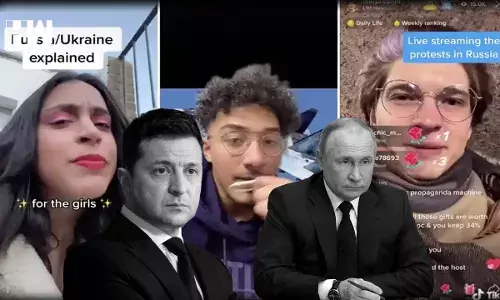The US President invited “a bunch of teenagers” to discuss, what is popularly been called, the ‘TikTok War’. Sounds absurd right? It does until we realize that this “bunch of teenagers” are entrepreneurs in their own right. On 3rd March 2022, the White House briefed 30 leading TikTok influencers about measures taken and goals set by the US government in Ukraine against the Russian attack. Each influencer has more than half a million followers and the ability to spread information faster and wider than any news outlet or newspaper.
It is not the first-time information about the war has been shared online. Vietnam War was the first televised war, the Taliban has made their fair share of disturbing videos to force the world to take them seriously. According to Kaityan Tiffany, writer at The Atlantic, the Iraq war was the ‘CNN War’ and Israel and Hamad had the first ‘war of Tweets’ back in 2012. But despite all these precedents, social media’s impact on the Ukraine war has been different. But why?
The novelty lies in the way information is being presented. And more importantly, the people who are presenting the information. The information is primarily being shared on TikTok. Until now it was considered just an app to share funny reels and dance videos. A study conducted by News Guard claimed that a new TikTok user would have their feed filled with war-related reels within 45 minutes of usage. At the same time, there is no distinction between real or fake news. Additionally, they have claimed that the app doesn’t have enough regulations in place to prevent the spread of propaganda and fake information. But before demanding additional regulations, there is a need to take a step back and think.
Is active censorship and screening information the right step forward? This situation can be seen as an opportunity to empower the masses into consuming news more mindfully. Censorship and added regulation are often ways through which responsibility is subverted. The responsibility to find authentic news is out-sourced, paving the way to conglomerates that are powerful enough to control what the people read, consume and ultimately think.
Gen Z influencers have made the news about the Russian attack ‘consumable’, especially for an audience that has historically remained indifferent to Global Politics. We often see the general audience disengaging from “unpleasant news pieces” post their initial fervor. But the Ukrainian issue is presented in the form of funny reels always on-point with social media’s sense of humor. An ideal example would be the viral reel where a young girl makes a TikTok of her day in a bomb shelter in Ukraine to the melody of Che La Luna.
The ones spreading the news aren’t politicians or extremist groups but the educated, westernized, English-speaking Gen Z. This has made the Russian attack personal to all. They have mastered the art of connecting with people. The social media culture transcends borders and regional identities. War information doesn’t just mean live bomb videos or personal experiences of people, even pages that previously posted make-up tutorials or cute reels of their pets have found creative ways to extend their solidarity. There has been a concerted effort to ensure that the masses remain invested in the war, and more importantly hopeful for Ukraine.
Ukraine and Russia are like David and Goliath, the most important aspect of keeping this story alive is the hope against hope that the underdog would triumph. President Zelenskyy has played his part well. “I don’t need a ride, I need ammo” with a single line his popularity skyrocketed, making him a national hero. He is constantly in touch with the outside world, urging them to not fight for Ukraine, but to fight with Ukraine. His unshaven face, disheveled appearance, and army clothing aren’t meant to make people feel sorry for him and his people, but to inspire them.
Every pro-Ukraine post is meant to show how the people of Ukraine are persevering, how they refuse to give in and give up. Along with this, there is also an effort to juvenilize the Russian army and caricaturize Putin. This is evident in Zelenskyy’s statement where he asks the mothers in Russia to stop their children from enlisting or the fact that the internet’s favorite adjective to describe Putin is ‘psycho’.
These developments are interesting but not unprecedented. This isn’t the first time a big country has been accused of bullying a small one. The US occupation of Vietnam was a very similar case. The active broadcasting of the war played a major role in mobilizing people against it which ultimately culminated in the Flower Revolution. The nature of the Russian regime makes Flower Revolution 2.0 an unlikely possibility. But this attack has finally awoken the only stakeholder who can bring lasting change in the society i.e., the people.
In the past decade, we have seen a rise in hyper-nationalism and autocracy across the globe. This incident has finally led people to stop and take notice of the state of affairs. It would take time but, historically speaking, it has only been the collective effort of the people that have brought about sweeping change, whether that was the storming of the Bastille or the falling of the Berlin wall. An optimist would see the Ukrainian war as the beginning of the end.
As an independent media platform, we do not take advertisements from governments and corporate houses. It is you, our readers, who have supported us on our journey to do honest and unbiased journalism. Please contribute, so that we can continue to do the same in future.

